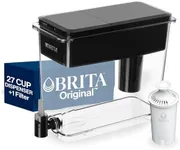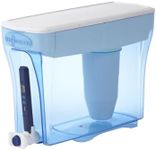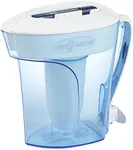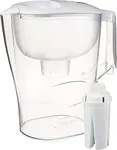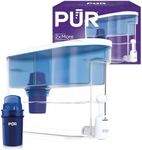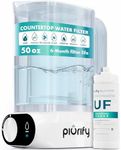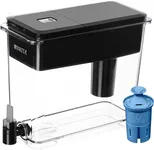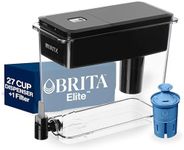Buying Guide for the Best Water Filter Pitchers
Choosing a water filter pitcher can make a big difference in how your water tastes and how safe it is to drink. Water filter pitchers are designed to be simple and convenient, usually fitting easily into your fridge and requiring no installation. When shopping, you'll want to look for a model that matches your family’s size, fits easily in your fridge, and addresses your specific water concerns. Think about your daily water use, the space you have, and most importantly, the kinds of impurities you want to filter out. Paying attention to a few key specs can help you find a pitcher that keeps your household happy and hydrated.Filter TypeFilter type refers to the kind of filtration technology used in the pitcher, such as activated carbon, ion exchange, or multi-stage filters. This is important because different filter types can remove different contaminants from your tap water, such as chlorine, heavy metals, and pesticides. If your main concern is taste and odor, a basic activated carbon filter may be enough. If you’re worried about specific contaminants like lead, look for advanced multi-stage filters that are certified for those contaminants. The right filter type for you depends on what’s in your tap water, so you might want to check a local water quality report to guide your choice.
Filtration CapacityFiltration capacity tells you how much water the filter can clean before it needs to be replaced—usually given in gallons or liters. This matters because a higher-capacity filter means less frequent changes and more convenience. Small pitchers may filter around 40 gallons before needing a new filter, while some larger or advanced models go higher. If you have a big family or use your filter for cooking, aim for a higher capacity. For single users or occasional use, smaller capacities may be perfectly fine and more affordable to maintain.
Pitcher Size and VolumePitcher size determines how much filtered water you can store at once, which is important for both convenience and fridge space. Smaller pitchers usually hold around 5–7 cups (about 1.2–1.7 liters), while larger ones can go up to 12 cups (almost 3 liters). A small household or individual user may find a compact pitcher easy to handle and store, but larger families or those who entertain guests often will appreciate a bigger pitcher that needs refilling less often. Think about your daily water consumption and how much space you have in your refrigerator to help you decide.
Filter Replacement IndicatorA filter replacement indicator is a feature that reminds you when it’s time to change the filter, either through a manual dial, digital counter, or color-changing display. This is important because forgetting to change the filter can mean your water isn’t as clean as you think. Some people prefer a simple visual check, while others like a more high-tech reminder. If you’re forgetful or just want extra peace of mind, a pitcher with an indicator might be a good fit for your routine.
CertificationsCertifications, like those from NSF or WQA, show that the pitcher and its filters have passed independent testing for removing certain contaminants. This is a crucial spec because it offers reassurance about the filter’s real-world performance. Certifications often cover things like chlorine taste and odor, heavy metals, or microplastics. If you want to be sure your pitcher actually delivers cleaner, safer water (not just promises it), look out for third-party certifications matching your water concerns.
Flow RateFlow rate describes how quickly water passes through the filter and collects in the pitcher, often measured as cups per minute. This is important because a slow flow can be frustrating if you use a lot of water at once. Faster flow rates offer more convenience but may sometimes mean less thorough filtration. If you’re filling bottles for the day or serving a group, you might appreciate a fast filter, while individuals using it just for drinking may not mind waiting a little longer for each fill.
